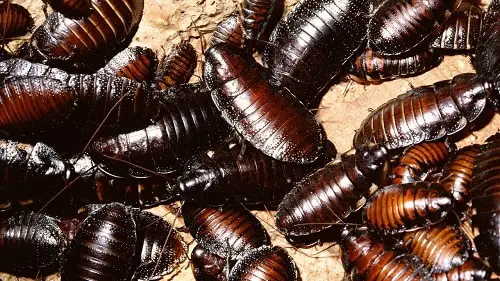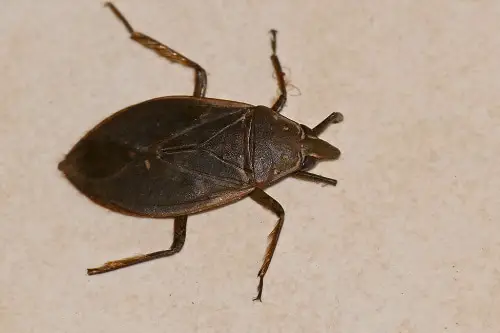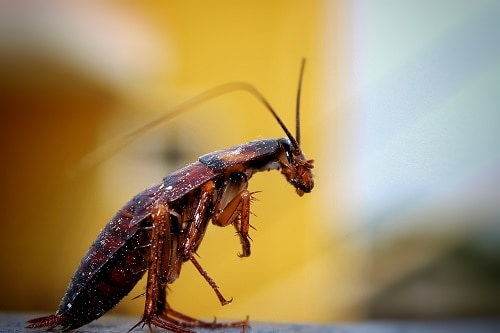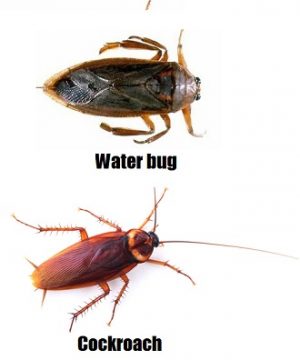- 5 Simple Tricks to Eliminate Maggots From Pet Waste - October 24, 2023
- Keep Your Outdoor Compost Piles Maggot-Free - October 24, 2023
- How to Get Rid of Maggots – Methods that Work - August 30, 2023
So how are these two insects both similar and different? Despite the fact that many people refer to several species of cockroaches as water bugs, in actuality, the giant water bug is an aquatic insect classified under the Hemiptera order for it’s scientific name.
The Corixidae and Nepidae families are true water bugs. They use their legs as paddles to move through the water. The members of the Gerridae family are also water bugs, but instead of using their legs as paddles, they take advantage of the surface tension to stay afloat. The members of the Halobates family are the only water bugs that are entirely aquatic and live in water most of the time, even though they have wings.
The difference between a cockroach and a water bug is mainly in two areas, their size and habitat. A roach is typically 1-1.5 inches long and a water bug about 2 inches. Water bugs find their natural habitat in water, while roaches are land insects.
When comparing the difference between these two, the cockroach vs water bug, the cockroach is the older and more adaptable species. Despite the fact that a water bug reproduces and locates in warm, moist areas, they are aquatic. The cockroach consumes any source of grub available. Cockroaches are nocturnal and hide in crevices during the day.
Cockroaches and water bugs are capable of spreading diseases to humans and can cause allergies and asthma and can be a real nuisance like other insects such as bed bugs. Cockroaches are attracted by food sources in homes and other warm, cozy places. Insecticides, powders and cockroach traps are temporary solutions for a cockroach or water bug infestation. Contact a professional pest control to search for options of extermination for all species of cockroach.

Color comparison – American, German and Oriental Cockroach
Among the various types of roaches, two cockroach species, the American and German cockroach is reddish-brown in color and considered large, as it sometimes exceeds 1.5 inches long in length. Oriental cockroaches tend to be black or dark brown in color. There is also a type commonly called the brown banded cockroach which has a light brown band around it’s head. Water bugs also tend to be black in color. Some cockroaches of this species like others, have wings, yet most are unable to fly.
Adults cockroaches have bright yellow margins in the back of the head, while others will just look like giant black bugs and it can be tricky trying to tell the difference. The male and the female of this species are very similar in appearance and size. The two have a couple of cerci at the tip of the abdomen, but only the male has a set of styli. A water bug and cockroach also have a different body shape, and you may notice that the water bug in the picture below has a more tapered shape at the rear. Some people can mistake a small roach for a bed bug as they are also dark brown with flat bodies, so before you take action to get rid of them, you need to make a proper water bug or cockroach identification.

Feeding habits
Water bug vs cockroach eating habits have some similarities, but also differences. Waterbugs and cockroaches usually feed on organic matter, however while looking for a food source, they can eat almost anything, even paper. They are commonly found in dark and moist areas such as basements, drains, sewers and tubs. Outside, they are mostly found in the courtyards, wood piles, tree holes or in the mulch. If you find an infestation of water bugs or cockroaches, contact the professional pest control to help you exterminate them. IHowever, if you are experiencing major cockroach infestations, it may be better to call someone straight away.
They are widely known, both by the high number of species and by the fact that they interact continuously with humans causing benefits or damages. Water bugs develop their entire life or part of it in the water. The larval or juvenile stage of the water bug is generally developed in water, and the stage of the adult in the terrestrial environment. At present, these can be found around the globe. There are also other species such as the German cockroach and the oriental cockroach.
Water bug attraction to water
Aquatic insects are those that at some stage, larvae or adult, and live in water most of the time(e.g., lakes, rivers). A small fraction of all insects, between 3-5% of the species are aquatic. Water bugs thrive in damp areas and prefer to live in water, but the low number is probably due to the limited amount of fresh water available in relation to the surface of the earth. However, water bugs are taxonomically diverse and interesting in structure and biology.
Giant water bugs are to a certain extent important for public health, such as those that help keep mosquito populations under control. As giant water bugs live in water, it is an important component of the aquatic ecosystems. Water bugs fly from one place of water to another at certain times of the year. They are prey for fish, birds and amphibians. These two types are detritivores, herbivores, predators and parasitoids. The giant water bug is found in the United States, particularly in the southern states.
Biology – the Facts
Generally, cockroaches make up a large group of insects whose evolution can be traced back to more than 300 million years ago. There are about 4,600 species and more than 460 genera, but only a few 30 live in habitats of humans and some 4 are considered common pests: the American cockroach, the Australian cockroach the German cockroach and the oriental cockroach. It is estimated that only 1 percent of all species is harmful to man, although they are known to pack a painful bite. They roughly have a lifespan of one year. The scientific name for “cockroach” comes from the Latin word Blatta Blattodea, which means “insect that flees from the light.”
What do roaches look like?
Cockroach and waterbug identification, and an ability to tell the difference between different common species, is an important step to proper pest management. They typically have a wide, flattened, oval body with a large flat plate attached to the chest (3 segments) which covers part of the head, which is small and has thin and flexible antennas attached to it.
A cockroach abdomen is divided into 10 segments. The entire body is protected by a hard exoskeleton covered with a waxy substance. Cockroaches have large compound eyes and mouthparts that are adapted for biting, chewing, and sucking liquid. They also have several receptors and are tactile. (check out the pics above)
Their wings are attached to the segments of the chest; the first pair of wings, the tegmina, are hard and serve to protect the second pair of membranous wings used for flying like other types of flying bugs. Cockroaches have 3 pairs of legs attached to the thoracic segments and the claws. The hind legs are longer than the front. All have along some small structures similar to thorns which may have sensory functions and help with movement in difficult terrain. You can also identify them by their faeces which look like ground coffee or pepper.

See photos above.
Size Comparisons
The difference in wtaer bug and cockroach size is variable; the longest giant water bug, Megaloblatta longipennis reaches 97 millimeters in length and 20 centimeters in size(sometomes referred to as an electric light bug). The heaviest, Macropanesthia rhinoceros is a little more than 30 grams. Cockroaches and water bugs have a multitude of colors, from light brown to black, and patterns of spots, stripes and circles that make up designs that you might not have thought a cockroach to have. Baby water bugs and cockroaches are obviously much smaller than the adults, but can be more difficult to identify.
The most effective natural method for cockroach and water bug control is prevention. Health conditions play an important role in the prevention of cockroach and water bug infestations.
Where do they hide?
Cockroaches can enter houses and apartments in infested bags and boxes of shopping. Inspect all groceries before saving them and keep the bags outside, in storage areas. The used boxes must be disposed immediately. Kitchen cabinets are a favourite place for water bugs and roaches to hide because they are dark. Another simple measure to prevent infestation is to keep doors and windows closed and make use of protective screens. The ventilation ducts of the attic must be examined, and the cracks and fissures in your house must be temporarily filled with pieces of wood shavings.
Cockroaches are often found near drains. By eliminating the sources of water can prevent infestation: repair any leaks in the bathrooms and the kitchen and avoid leaving pots of water outside for long periods of time. Get rid of standing water around the house. The mulch should be used several inches away from the foundation of the house. The wood for the fireplace should not be stacked near the house; it must be inspected carefully before bringing it in and using it.
Trash should be disposed off on a regular basis. Dirty dishes should never be left in the kitchen during the night. Keep cooking appliances clean and free of debris. Despite the fact that these measures can prevent the cockroaches spreading, professionals who are pest experts should be consulted to treat existing cockroach infestations before they get out of hand.

Solutions
Getting rid of cockroaches is not simple. They have a great capacity for adaptation and survival. In addition, when they invade a home, they never do it alone, but in colonies of hundreds. This is why killing roaches should be a properly planned process, minimizing the risks and discomforts and increasing the effectiveness of the measures applied.
Today there are numerous methods to put an end to them from the traps, roach baits or sprays to professional services of fumigation which can be carried out by commercial pest control companies.
Cockroaches do not like the scent of herbs. Put some crushed bay leaves or a little bit of mint in areas where they are. With the following trick (the most effective found to date), not only will you be able to eliminate cockroaches that you see, but it has an impressive residual effect that we will discuss at the end.
The procedure to make this homemade bait is very simple. You will need:
- Boric Acid
- Sugar confectionery or spray
- A few tablespoons of milk
Put 1 tablespoon of boric acid and a spoonful of sugar in a bowl and stir. Then, add milk little by little and keep stirring to make a semi-solid paste that can be formed into small balls. Make several balls the size of a pea and put them at places where you think they have made their homes. Some people also swear by a mixture of baking soda and sugar for getting rid of cockroaches. A cockroach or water bug also gives off a bad odor, so you may have to use a spray to neutralise the smell.
A water bug is a general term for insects such as cockroaches or the American cockroach that gather around water sources. They are attracted to food and water, so the best way to avoid them is to make sure that the remains of meals are not left out in the cold. Here’s how to get rid of water bugs:
How to prevent an infestation
- Keep pet food well covered or box it when not in use.. The water bugs or cockroaches can feed on the pet feed to survive. If possible, determine feeding hours for your pet so your dog or cat can eat and you can wash the bowl immediately. This will certainly help with effective treatment.
- Place food inside the refrigerator when possible. If you cannot refrigerate, put it in airtight containers to keep away from pests.
- Use garbage cans with tight lids. The garbage cans and compost piles that are open to the air will attract, feed and incubate more insects.
- Keep the outside of your house and your backyard tidy. These household pests live in places that are rarely cleaned.
- Remove old boxes of cardboard. These are popular hiding places for the cockroach or water bug.
- Look for standing water inside and outside the house. The pet water containers, tarpaulins, water glasses, dishes, pots, bird baths and rain water can act as cozy places to incubate water bugs. Such places help them multiply very quickly.
- Cover all containers of water properly. If you cannot cover water in places like bird baths, keep changing the water regularly to keep it clean.· Thoroughly wash down the kitchen with a disinfectant to keep water bugs and cockraoches at bay. Be sure to also clean appliances such as the toaster, blender, grill and other places where particles are likely to get trapped.
Some further measures you could take
- Limit the intake of meals to one room in the house. Discourage children to eat in their rooms or in front of the television. This will help keep the rest of the house tidy. It is best to decide one eating spot in the house for the whole family like the kitchen or the dining room.
- Sweep the dining room on a regular basis .
- Shampoo the rugs or carpets with soap and water at least once a year.
- Repair leaky faucets inside and outside the house. Be sure to place these items on your list of things to do immediately. Cockroaches and water bugs can remain alive for a long time if you have a constant source of water.
- Examine your home for signs of ill-fitting doors or windows. Replace them if possible or line them for airtight fit, so that insects cannot enter. You may need to enter a crawl space to check out areas of your house for water bug or cockroach signs.
- Fill in the gaps in particular to reduce the accumulation of water.
- Seal the holes in the insulator or on the walls. This will eliminate all forms of pest that are bound to create a nest.
- Identify spots where nests are located. This will help you to get rid of the problem quickly.
- Pour in 2 to 4 cups (0.4 to 0.9l) of distilled white vinegar in all your drainage pipes. This includes your sinks, bath tubs, shower areas and toilet.
Some extra tips
- Pour some liquid dish detergent in your pool, if you notice an infestation. Shut off the pump. When the cockroaches or water bugs die, they float to the surface of the water. After a few hours you can use a pool skimmer to purify the water. Then drain out that water and fill your pool with fresh water.
- Create a mixture with one half of powdered sugar and one half of sodium bicarbonate. Sprinkle the mixed fine dust in the area of the waterbug or cockroach infestation. Wait for the insects to die and then clean the area thoroughly.
- Sprinkle infested areas with borax. The boric acid will kill the insects after which you can wash over the place.
- The water bugs and cockroaches are able to avoid large accumulations of Borax, so make sure that it is a very fine powder that is sprinkled in and around their nests.
- Use roach traps for effective treatment. These traps use a poison concentrated within a box. The insects are attracted and die within the box for safe disposal.
- Call an exterminator or wildlife management consultant. If your house is infested with insects in water, you may need to use a more aggressive chemical treatment and control methods. In this case, you will have to evacuate your home and tidy up the kitchen and other surfaces before use!
FAQs
Water bug and Palmetto bugs
There is no difference between a cockroach and an insect palmetto. In the United States, particularly in the southern region, the American cockroach is known as a palmetto bug or water bug. Originating from the African tropics, it is believed that the American cockroaches were brought to North America on a slave ship.
Reference: https://en.wikipedia.org/wiki/Waterbug

